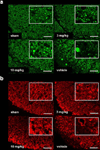Diffusion tensor imaging detects treatment effects of FTY720 in experimental autoimmune encephalomyelitis mice
- PMID: 23939596
- PMCID: PMC3838438
- DOI: 10.1002/nbm.3012
Diffusion tensor imaging detects treatment effects of FTY720 in experimental autoimmune encephalomyelitis mice
Abstract
Fingolimod (FTY720) is an orally available sphingosine-1-phosphate (S1P) receptor modulator reducing relapse frequency in patients with relapsing-remitting multiple sclerosis (RRMS). In addition to immunosuppression, neuronal protection by FTY720 has also been suggested, but remains controversial. Axial and radial diffusivities derived from in vivo diffusion tensor imaging (DTI) were employed as noninvasive biomarkers of axonal injury and demyelination to assess axonal protection by FTY720 in experimental autoimmune encephalomyelitis (EAE) mice. EAE was induced through active immunization of C57BL/6 mice using myelin oligodendrocyte glycoprotein peptide 35-55 (MOG(35-55)). We evaluated both the prophylactic and therapeutic treatment effect of FTY720 at doses of 3 and 10 mg/kg on EAE mice by daily clinical scoring and end-point in vivo DTI. Prophylactic administration of FTY720 suppressed the disease onset and prevented axon and myelin damage when compared with EAE mice without treatment. Therapeutic treatment by FTY720 did not prevent EAE onset, but reduced disease severity, improving axial and radial diffusivity towards the control values without statistical significance. Consistent with previous findings, in vivo DTI-derived axial and radial diffusivity correlated with clinical scores in EAE mice. The results support the use of in vivo DTI as an effective outcome measure for preclinical drug development.
Keywords: FTY720; axial diffusivity; axonal injury; demyelination; diffusion tensor imaging; experimental autoimmune encephalomyelitis; multiple sclerosis; radial diffusivity.
Copyright © 2013 John Wiley & Sons, Ltd.
Figures







Similar articles
-
FTY720, sphingosine 1-phosphate receptor modulator, ameliorates experimental autoimmune encephalomyelitis by inhibition of T cell infiltration.Cell Mol Immunol. 2005 Dec;2(6):439-48. Cell Mol Immunol. 2005. PMID: 16426494
-
Fingolimod (FTY720), sphingosine 1-phosphate receptor modulator, shows superior efficacy as compared with interferon-β in mouse experimental autoimmune encephalomyelitis.Int Immunopharmacol. 2011 Mar;11(3):366-72. doi: 10.1016/j.intimp.2010.10.005. Epub 2010 Oct 16. Int Immunopharmacol. 2011. PMID: 20955831
-
Relapse of experimental autoimmune encephalomyelitis after discontinuation of FTY720 (Fingolimod) treatment, but not after combination of FTY720 and pathogenic autoantigen.Biol Pharm Bull. 2011;34(6):933-6. doi: 10.1248/bpb.34.933. Biol Pharm Bull. 2011. PMID: 21628899
-
[New therapeutic approach for autoimmune diseases by the sphingosine 1-phosphate receptor modulator, fingolimod (FTY720)].Yakugaku Zasshi. 2009 Jun;129(6):655-65. doi: 10.1248/yakushi.129.655. Yakugaku Zasshi. 2009. PMID: 19483408 Review. Japanese.
-
FTY720 (fingolimod) in Multiple Sclerosis: therapeutic effects in the immune and the central nervous system.Br J Pharmacol. 2009 Nov;158(5):1173-82. doi: 10.1111/j.1476-5381.2009.00451.x. Epub 2009 Oct 8. Br J Pharmacol. 2009. PMID: 19814729 Free PMC article. Review.
Cited by
-
Immune System and Brain/Intestinal Barrier Functions in Psychiatric Diseases: Is Sphingosine-1-Phosphate at the Helm?Int J Mol Sci. 2023 Aug 10;24(16):12634. doi: 10.3390/ijms241612634. Int J Mol Sci. 2023. PMID: 37628815 Free PMC article. Review.
-
Delimiting MOGAD as a disease entity using translational imaging.Front Neurol. 2023 Dec 7;14:1216477. doi: 10.3389/fneur.2023.1216477. eCollection 2023. Front Neurol. 2023. PMID: 38333186 Free PMC article. Review.
-
Cbl-b-deficient mice express alterations in trafficking-related molecules but retain sensitivity to the multiple sclerosis therapeutic agent, FTY720.Clin Immunol. 2015 May;158(1):103-13. doi: 10.1016/j.clim.2015.03.018. Epub 2015 Mar 28. Clin Immunol. 2015. PMID: 25829233 Free PMC article.
-
"A new imaging modality to non-invasively assess multiple sclerosis pathology".J Neuroimmunol. 2017 Mar 15;304:81-85. doi: 10.1016/j.jneuroim.2016.10.002. Epub 2016 Oct 8. J Neuroimmunol. 2017. PMID: 27773433 Free PMC article. Review.
-
Fingolimod-improved axonal and myelin integrity of white matter tracts associated with multiple sclerosis-related functional impairments.CNS Neurosci Ther. 2018 May;24(5):412-419. doi: 10.1111/cns.12796. Epub 2018 Jan 5. CNS Neurosci Ther. 2018. PMID: 29316271 Free PMC article.
References
-
- Weinshenker BG. Epidemiology of multiple sclerosis. Neurol Clin. 1996;14(2):291–308. - PubMed
-
- Noseworthy JH, Lucchinetti C, Rodriguez M, Weinshenker BG. Multiple sclerosis. N Engl J Med. 2000;343(13):938–952. - PubMed
-
- Bitsch A, Schuchardt J, Bunkowski S, Kuhlmann T, Bruck W. Acute axonal injury in multiple sclerosis. Correlation with demyelination and inflammation. Brain. 2000;123(Pt 6):1174–1183. - PubMed
-
- Trapp BD, Nave KA. Multiple sclerosis: An immune or neurodegenerative disorder? Annual Review of Neuroscience. 2008;31:247–269. - PubMed
-
- Hemmer B, Hartung HP. Toward the development of rational therapies in multiple sclerosis: what is on the horizon? Ann Neurol. 2007;62(4):314–326. - PubMed
Publication types
MeSH terms
Substances
Grants and funding
LinkOut - more resources
Full Text Sources
Other Literature Sources

